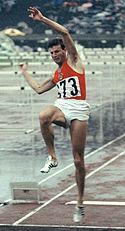Mistrzostwa Europy w Lekkoatletyce 1971 – skok w dal mężczyzn
| |||
Skok w dal mężczyzn był jedną z konkurencji rozgrywanych podczas X Mistrzostw Europy w Helsinkach. Kwalifikacje rozegrano 10 sierpnia, a finał 11 sierpnia 1971. Zwycięzcą tej konkurencji został reprezentant Niemieckiej Republiki Demokratycznej Max Klauß. W rywalizacji wzięło udział trzydziestu zawodników z czternastu reprezentacji.
Rekordy
| Rekord świata | 8,90 | Meksyk, Meksyk | 18.10.1968[1] | |
| Rekord Europy | 8,35 | Meksyk, Meksyk | 19.10.1967[2] | |
| Rekord mistrzostw | 8,00 | Ateny, Grecja | 18.09.1969 |
Wyniki
Kwalifikacje
Minimum wynosiło 7,70 m.
| Poz. | Zawodnik | Reprezentacja | Grupa | #1 | #2 | #3 | Rezultat | Uwagi |
|---|---|---|---|---|---|---|---|---|
| 1. | Tõnu Lepik | B | 7,93 | – | – | 7,93 | Q | |
| 2. | Lynn Davies | B | x | 7,90 | – | 7,90 | Q | |
| 3. | Christian Tourret | A | 7,82 | – | – | 7,82 | Q | |
| 4. | Jacques Rousseau | B | 7,68 | x | 7,82 | 7,82 | Q | |
| 5. | Josef Schwarz | B | x | 7,80 | – | 7,80 | Q | |
| 6. | Vasile Sărucan | A | 7,79 | – | – | 7,79 | Q | |
| 7. | Igor Ter-Owanesian | B | 7,77 | – | – | 7,77 | Q | |
| 8. | Jan Kobuszewski | B | x | 7,77 | – | 7,77 | Q | |
| 9. | Reijo Toivonen | B | x | x | 7,77 | 7,77 | Q | |
| 10. | Terje Haugland | A | 7,52 | 7,75 | – | 7,75 | Q | |
| 11. | Stanisław Szudrowicz | B | 7,75 | – | – | 7,75 | Q | |
| 12. | Finn Bendixen | B | 7,60 | 7,67 | 7,74 | 7,74 | Q | |
| 13. | Max Klauß | A | 7,67 | 7,72 | – | 7,72 | Q | |
| 14. | Wałerij Pidłużny | A | 7,63 | x | 7,72 | 7,72 | Q | |
| 15. | Mauri Myllymäki | A | 7,51 | 7,57 | 7,70 | 7,70 | Q | |
| 16. | Klaus Beer | B | 7,24 | 7,65 | 7,42 | 7,65 | ||
| 17. | Hans Baumgartner | A | 7,43 | 7,42 | 7,62 | 7,62 | ||
| 18. | Dušan Košutić | B | 7,49 | 7,60 | x | 7,60 | ||
| 19. | Miljenko Rak | A | 7,46 | 7,58 | 7,56 | 7,58 | ||
| 20. | Andreas Gloerfeld | A | 7,28 | 7,46 | 7,57 | 7,57 | ||
| 21. | Jesper Tørring | B | 7,52 | 7,33 | x | 7,52 | ||
| 22. | Valeriu Jurcă | B | 7,50 | 7,33 | x | 7,50 | ||
| 23. | Jack Pani | A | 7,38 | 7,41 | 7,33 | 7,41 | ||
| 24. | Nenad Stekić | A | 7,35 | x | 7,25 | 7,35 | ||
| 25. | Gürol Dinsel | B | 7,27 | 5,36 | x | 7,27 | ||
| 26. | Geoff Hignett | A | 7,17 | 7,25 | 7,25 | 7,25 | ||
| 27. | Henrik Kalocsai | B | 7,11 | 7,24 | x | 7,24 | ||
| 28. | Gábor Katona | A | 7,22 | 7,20 | 7,10 | 7,22 | ||
| 29. | Jaroslav Brož | A | x | 5,92 | x | 5,92 | ||
| – | Alan Lerwill | B | x | x | x | NM |
Finał
| Poz. | Zawodnik | Reprezentacja | Próby | Wynik | |||||
|---|---|---|---|---|---|---|---|---|---|
| 1 | 2 | 3 | 4 | 5 | 6 | ||||
| Max Klauß | 7,87 | 7,71 | 7,92 | 7,75 | x | x | 7,92 | ||
| Igor Ter-Owanesian | 7,91w | 7,64 | 7,87 | 7,71 | 7,48 | 7,41 | 7,91w | ||
| Stanisław Szudrowicz | 7,44 | 7,75 | 7,87 | x | x | 7,47 | 7,87 | ||
| 4. | Lynn Davies | 7,85 | x | 7,83 | x | 7,74 | 7,74 | 7,85 | |
| 5. | Mauri Myllymäki | 7,58 | 7,85 | 7,66 | x | 7,64 | x | 7,85 | |
| 6. | Reijo Toivonen | x | 7,59 | 7,85 | x | x | x | 7,85 | |
| 7. | Tõnu Lepik | 7,59 | 7,75 | 7,58 | 7,07 | 7,70 | 7,78 | 7,78 | |
| 8. | Jan Kobuszewski | 7,36 | 7,75 | 7,64 | 5,96 | 7,60 | 5,05 | 7,75 | |
| 9. | Christian Tourret | 7,74 | 7,64 | 7,63 | 7,74 | ||||
| 10. | Wałerij Pidłużny | 7,68 | 7,64 | 6,13 | 7,68 | ||||
| 11. | Jacques Rousseau | 7,17 | 7,50 | 7,56 | 7,56 | ||||
| 12. | Josef Schwarz | x | 5,92 | 7,50 | 7,50 | ||||
| 13. | Terje Haugland | 7,41 | |||||||
| 14. | Finn Bendixen | 7,32 | |||||||
| 15. | Vasile Sărucan | 6,05 | |||||||
Przypisy
- ↑ Progression of IAAF World Records. 2015 Edition, IAAF, s. 175 [dostęp 2019-02-23] (ang.).
- ↑ Mirko Jalava (red.): Göteborg 2006 Statistics Handbook. Göteborg: European Athletics, 2006, s. 366.
Bibliografia
- Berlin 2018 Statistics Handbook, European Athletics, s. 540 [dostęp 2019-02-23] [zarchiwizowane z adresu 2019-09-14] (ang.).
- European Athletics Championships – Helsinki 1971, European Athletics [dostęp 2019-02-23] (ang.).
- Od tytułu do tytułu. „Lekkoatletyka”. XVI (10), s. 4-27, październik 1971. Zygmunt Głuszek (red. naczelny). Warszawa: RSW Prasa (pol.).
| ||||
Media użyte na tej stronie
Pictograms of Olympic sports – . This is an unofficial sample picture. Images of official Olympic pictograms for 1948 Summer Olympics and all Summer Olympics since 1964 can be found in corresponding Official Reports.
An icon that represents a gold medal
An icon that represents a silver medal
An icon that represents a bronze medal
The flag of Navassa Island is simply the United States flag. It does not have a "local" flag or "unofficial" flag; it is an uninhabited island. The version with a profile view was based on Flags of the World and as a fictional design has no status warranting a place on any Wiki. It was made up by a random person with no connection to the island, it has never flown on the island, and it has never received any sort of recognition or validation by any authority. The person quoted on that page has no authority to bestow a flag, "unofficial" or otherwise, on the island.
Flag of Romania, (21 August 1965 - 22 December 1989/officialy 27 December 1989).
Construction sheet of the Flag of Romania as depicted in Decree nr. 972 from 5 November 1968.
- l = 2/3 × L
- C = 1/3 × L
- S = 2/5 × l
Flag of Romania, (21 August 1965 - 22 December 1989/officialy 27 December 1989).
Construction sheet of the Flag of Romania as depicted in Decree nr. 972 from 5 November 1968.
- l = 2/3 × L
- C = 1/3 × L
- S = 2/5 × l
Flaga Finlandii
Flag of the Socialist Federal Republic of Yugoslavia (1946-1992).
The design (blazon) is defined in Article 4 of the Constitution for the Republic of Yugoslavia (1946). [1]
Flag of the Socialist Federal Republic of Yugoslavia (1946-1992).
The design (blazon) is defined in Article 4 of the Constitution for the Republic of Yugoslavia (1946). [1]
(c) Bundesarchiv, Bild 183-L0816-0385 / CC-BY-SA 3.0
Igor Ter-Ovanesyan, 1964 Olympics




















